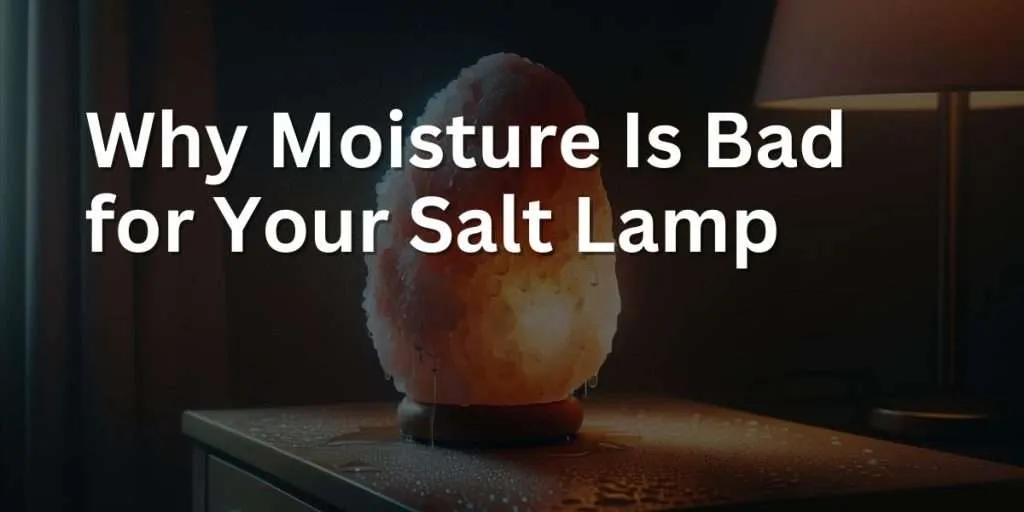Have you ever noticed your Himalayan salt lamp feeling damp or even wet to the touch? This isn’t a sign of a defective lamp; in fact, it’s a natural property of Himalayan salt.
In this post, we delve into the hygroscopic nature of salt lamps — their ability to attract and absorb moisture from the air. We’ll discuss what causes this phenomenon, the implications for your lamp’s placement and care, and how to handle it to ensure the longevity and effectiveness of your glowing pink treasure.
From practical tips to prevent excessive moisture to understanding how your lamp interacts with its environment, we’ll cover all you need to ensure that your Himalayan salt lamp remains a soothing and safe addition to your home.
Key Takeaways: Why Your Himalayan Salt Lamp Is Wet
Hygroscopic nature. Himalayan salt lamps absorb moisture from the air, leading to the surface of the lamp becoming wet, a process known as hygroscopy.
High humidity levels. In environments with high humidity, salt lamps are more prone to ‘sweating’ as they attract more moisture.
Infrequent use. When the lamp is not turned on regularly, the heat from the bulb isn’t able to evaporate the accumulated moisture, resulting in a damp lamp.
Seasonal changes. During certain seasons, like summer or the rainy season, increased humidity can cause the lamp to become wet more frequently.
Lack of proper ventilation. Poorly ventilated rooms can increase humidity levels, leading to more moisture being absorbed by the lamp.
Direct exposure to moisture. If the lamp is placed near sources of water vapor, like showers or kettles, it can get wet due to direct exposure.
Hygroscopic nature of Salt Lamps
The hygroscopic nature of salt lamps speaks to their ability to attract and absorb water molecules from the surrounding environment. This characteristic is central to the functionality of Himalayan salt lamps.
As they draw in moisture, these salt crystals also capture airborne contaminants, which remain on the salt’s surface. It’s this process that underlines the lamp’s purifying capabilities, often seen as a benefit to indoor air quality.
When illuminated, the gentle warmth of the light bulb helps to evaporate the absorbed moisture, which has the added benefit of releasing negative ions into the air. These ions are touted to combat the plethora of positive ions generated by electronic devices, thereby contributing to a feeling of freshness akin to the air after a thunderstorm or by a waterfall.
High humidity levels Cause Wet Salt Lamps
High humidity levels can indeed result in wet salt lamps, a natural response due to the inherent properties of Himalayan pink salt. The salt, hygroscopic by nature, actively attracts water vapor, which is often abundant in more humid environments. This effect can be particularly noted on those days when the air feels heavy with moisture.
Embracing the lamp’s interaction with humidity offers a unique perspective on its role within a home. While the lamp may appear wet or “sweating,” this indicates it is actively engaging with its environment. The damp surface signifies the lamp’s ongoing process of hygroscopic action, which in turn, is part of what many believe contributes to its air purifying attributes.
If you are finding excess water around your salt lamp you may need to look into other forms of humidty removal such as a dehumidifier.
Infrequent use Cause Wet Salt Lamps
When these lamps are used consistently, the heat produced by the light bulb inside them causes any accumulated moisture to evaporate, preventing the salt from becoming overly wet.
In instances of sporadic usage, however, salt lamps may not generate enough heat to evaporate all the moisture they absorb. This can lead to the exterior of the lamp becoming damp or wet to the touch.
To maintain the pristine condition and longevity of a salt lamp, a regular usage schedule is recommended. Regular illumination not only enhances the aesthetic appeal, by casting a warm, amber glow, but also preserves its structural integrity by keeping the moisture levels in check.
Creating a routine where the salt lamp is lit for a few hours each day can establish a cycle of moisture absorption and evaporation. This steady rhythm helps to prevent the pooling of water which can occur around the base of an infrequently used salt lamp, safeguarding the surfaces on which the lamp is placed.

Why Is Moisture Bad for Your Salt Lamp
Moisture affects Himalayan salt lamps by triggering their hygroscopic properties. When exposed to damp environments, these salt crystals attract water molecules from the air. While this natural dehumidifying process can benefit air quality by removing water vapor that may contain allergens, excessive moisture can lead to the dissolution of the salt lamp.
This not only can diminish the structural integrity of the salt crystal but also may lead to leakage problems on the surfaces where the lamp is placed.
Protecting salt lamps from high humidity levels preserves their longevity and aesthetic appeal. Using a salt lamp in a well-ventilated area reduces moisture accumulation and maintains the lamp’s dry, crystalline form. Ensuring they are placed away from sources of steam or water such as kettles or showers can keep the lamp’s surface dry and fully functional.
Why removing moisture from the air is a good thing.
Although you might want to place your salt lamp on a saucer and dry it regularly to prevent any damage to furniture or the electricity, the fact that your Himalayan salt lamp is leaking is actually a good thing.
If the air in your home is particularly damp this can encourage the growth of mold which can, in turn, lead to infections and illness. The likelihood is the majority of this water comes from breathing, cooking, and taking a bath or shower so there’s not a huge amount you can do about it other than turning on extractors where you can or getting a dehumidifier.
When you have a leaking salt lamp it is taking excess moisture out of the room.
However, if your lamp is constantly wet it won’t last as long so you might want to keep it away from particularly damp areas.
Whilst some people say a leaking salt lamp needs a higher wattage bulb, that won’t help and in fact may give you more leaking. As they say when a salt lamp cries it’s a sign of dampness in your house.
Keeping your Himalayan salt lamp dry
Keeping your Himalayan salt lamp dry is essential for maintaining its aesthetic and functional qualities. The natural hygroscopic characteristics of Himalayan salt enable these lamps to absorb moisture from the air, which is effectively managed by the warmth they emit when lit.
Regular use of the lamp plays a crucial role; the heat from the light bulb inside the lamp warms the salt, encouraging the evaporation of any absorbed moisture and thus sustaining a dry, clean surface.
To enhance the dryness of a Himalayan salt lamp, placing it in environments with low humidity can be beneficial. This positioning minimizes the amount of moisture in the air around the lamp, reducing the amount it can absorb.
When the lamp is not in use for extended periods, employing protective measures such as a breathable cover can prevent excessive moisture accumulation. The cover allows air to circulate while shielding the salt from additional moisture exposure, keeping the lamp dry and prolonging its life.
Careful handling and placement of the salt lamp further ensure its preservation. It’s advisable to place the lamp on a raised, waterproof base to guard against any unintended water contact from the surface beneath.








